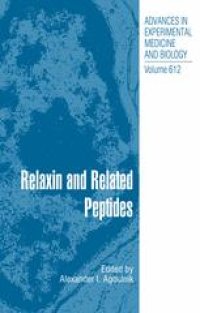
Ebook: Relaxin and Related Peptides
- Tags: Endocrinology, Cell Biology, Cancer Research
- Series: Advances in Experimental Medicine and Biology 612
- Year: 2007
- Publisher: Springer-Verlag New York
- Edition: 1
- Language: English
- pdf
Relaxin and Related Peptides discusses the established paradigms, the contradictions, and the most recent findings and future directions in the field of relaxin research. The array of diverse topics are highlighted, ranging from evolution of relaxin family peptides and receptors to their cell signaling, from the role of relaxin in reproduction to the newly discovered functions in cancer progression and in the nervous system. The four major ongoing areas of research described in this book will likely attract investigators for years to come, since many basic scientific questions remain unanswered at this time. The availability of structural databases, new experimental techniques, and high quality hormone preparations, antibodies and other reagents enable rigorous investigation. Relaxin and Related Peptides offers a fresh perspective along with different points of view, opinions and disagreements.
This comprehensive book contains the latest information on diverse biological functions of relaxin and related peptide found since the recent discovery of relaxin receptors. Along with well-established effects of relaxin in female reproduction, it discusses the recently discovered role of relaxin and insulin-like 3 peptide in male reproductive organs, vascular system, maintenance of extracellular matrix in healthy and fibrotic tissues, cancer progression, and brain. The book also describes the evolution of relaxin family peptides and their receptors, molecular mechanisms of ligand/receptor interaction and the analysis of activated signaling pathways. It is addressed to a wide audience of researchers and the students in various areas of basic biology and medicine.
This comprehensive book contains the latest information on diverse biological functions of relaxin and related peptide found since the recent discovery of relaxin receptors. Along with well-established effects of relaxin in female reproduction, it discusses the recently discovered role of relaxin and insulin-like 3 peptide in male reproductive organs, vascular system, maintenance of extracellular matrix in healthy and fibrotic tissues, cancer progression, and brain. The book also describes the evolution of relaxin family peptides and their receptors, molecular mechanisms of ligand/receptor interaction and the analysis of activated signaling pathways. It is addressed to a wide audience of researchers and the students in various areas of basic biology and medicine.
Content:
Front Matter....Pages i-xxii
The Evolution of the Relaxin Peptide Family and Their Receptors....Pages 1-13
Relaxin, the Relaxin-Like Factor and Their Receptors....Pages 14-25
Diverse Signalling Mechanisms Used by Relaxin in Natural Cells and Tissues: The Evolution of a “Neohormone”....Pages 26-33
Relaxin Physiology in the Female Reproductive Tract during Pregnancy....Pages 34-48
Relaxin and Related Peptides in Male Reproduction....Pages 49-64
The Vascular Actions of Relaxin....Pages 65-87
The Effects of Relaxin on Extracellular Matrix Remodeling in Health and Fibrotic Disease....Pages 88-103
Relaxin-Like Ligand-Receptor Systems Are Autocrine/Paracrine Effectors in Tumor Cells and Modulate Cancer Progression and Tissue Invasiveness....Pages 104-118
Relaxin-Family Peptide and Receptor Systems in Brain: Insights from Recent Anatomical and Functional Studies....Pages 119-137
Back Matter....Pages 139-142
This comprehensive book contains the latest information on diverse biological functions of relaxin and related peptide found since the recent discovery of relaxin receptors. Along with well-established effects of relaxin in female reproduction, it discusses the recently discovered role of relaxin and insulin-like 3 peptide in male reproductive organs, vascular system, maintenance of extracellular matrix in healthy and fibrotic tissues, cancer progression, and brain. The book also describes the evolution of relaxin family peptides and their receptors, molecular mechanisms of ligand/receptor interaction and the analysis of activated signaling pathways. It is addressed to a wide audience of researchers and the students in various areas of basic biology and medicine.
Content:
Front Matter....Pages i-xxii
The Evolution of the Relaxin Peptide Family and Their Receptors....Pages 1-13
Relaxin, the Relaxin-Like Factor and Their Receptors....Pages 14-25
Diverse Signalling Mechanisms Used by Relaxin in Natural Cells and Tissues: The Evolution of a “Neohormone”....Pages 26-33
Relaxin Physiology in the Female Reproductive Tract during Pregnancy....Pages 34-48
Relaxin and Related Peptides in Male Reproduction....Pages 49-64
The Vascular Actions of Relaxin....Pages 65-87
The Effects of Relaxin on Extracellular Matrix Remodeling in Health and Fibrotic Disease....Pages 88-103
Relaxin-Like Ligand-Receptor Systems Are Autocrine/Paracrine Effectors in Tumor Cells and Modulate Cancer Progression and Tissue Invasiveness....Pages 104-118
Relaxin-Family Peptide and Receptor Systems in Brain: Insights from Recent Anatomical and Functional Studies....Pages 119-137
Back Matter....Pages 139-142
....